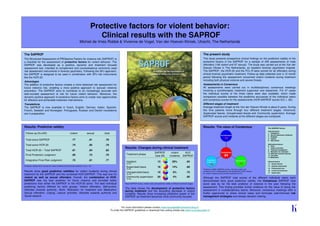
Saprof Protective Factors for Violence Risk. Prospective Clinical Results. Poster 2011
- 1. Protective factors for violent behavior: Clinical results with the SAPROF Michiel de Vries Robbé & Vivienne de Vogel, Van der Hoeven Kliniek, Utrecht, The Netherlands The SAPROF The present study The Structured Assessment of PROtective Factors for violence risk (SAPROF) is This study presents prospective clinical findings on the predictive validity of the a checklist for the assessment of protective factors for violent behavior. The protective factors in the SAPROF for a sample of 245 assessments of male SAPROF was developed as a positive, dynamic and treatment focused offenders (148 violent and 97 sexual). The study was carried out at the Van der assessment tool, intended to complement and counterbalance commonly used Hoeven Kliniek in The Netherlands, an inpatient forensic psychiatric hospital. risk assessment instruments in forensic psychiatry. Following the SPJ approach, The SAPROF, the HCR-20 and the PCL-R were scored for all offenders during the SAPROF is designed to be used in combination with SPJ risk instruments clinical forensic psychiatric treatment. Follow-up data collected over a 12 month like the HCR-20. period following the assessment concerned violent incidents during treatment including both physical violence and severe threats. Advantages The addition of protective factors creates a more balanced risk assessment for Assessments in Consensus future violence risk, enabling a more positive approach to (sexual) violence All assessments were carried out in multidisciplinary consensus meetings prevention. The SAPROF aims to contribute to an increasingly accurate and involving a sociotherapist, treatment supervisor and researcher. For 47 cases well-rounded assessment of risk for future violent behavior. Moreover, the the individual scores of the three raters were also available, which made dynamic positive approach of protective factors aims to create new opportunities comparison possible between the predictive accuracies of the individual raters for effective and achievable treatment interventions. and consensus scores for the assessments (HCR-SAPROF scores ICC = .80). Translations Different stages of treatment The SAPROF is now available in Dutch, English, German, Italian, Spanish, Average treatment length at the Van der Hoeven Kliniek is about 6 years. During French, Swedish and Norwegian. Portuguese, Russian and Danish translations this time patients move through four different treatment stages: Intramural, are in preparation. Supervised leaves, Unsupervised leaves and Community supervision. Average SAPROF scores and incidents at the different stages are compared. Results: Predictive validity Results: The value of Consensus The SAPROF factors Internal factors Follow-up (N=245) violent sexual total 1. Intelligence Sociotherapist 2. Secure attachment childhood 3. Empathy .70 4. Coping Total score SAPROF .77 .81 .78 5. Self-control Motivational factors Total score HCR-20 .74 .85 .79 6. Work Results: Changes during clinical treatment 7. Leisure activities Total HCR-20 – Total SAPROF .81 .84 .82 8. Financial management 9. Motivation for treatment SAPROF violent AUC Consensus 10. Attitudes towards authority Final Protection Judgment .69 .73 .70 Treatment phase .84 total (M) incidents SAPROF 11. Life goals 12. Medication Integrative Final Risk Judgment .75 .81 .77 Treatment Researcher Inpatient 13 29% .65 Supervisor External factors (N=34) .74 .75 13. Social network Predictive validity (AUC-values) for violent incidents during clinical treatment, all p < .05. 14. Intimate relationship Supervised leave 18 14% .68 15. Professional care (N=64) Predictive validity SAPROF scores: individual raters and 16. Living circumstances Results show good predictive validities for violent incidents during clinical Unsupervised leave 19 6% .75 consensus from multidisciplinary risk assessment (AUC-values) for violent incidents during clinical treatment (N=47). 17. Supervision treatment for the SAPROF and the combined HCR-SAPROF. This was true for (N=48) violent as well as sexual offenders. Overall, the combination of HCR- Community supervision 20 4% .80 Although the SAPROF total scores of the different individual raters each (N=99) SAPROF was the best predictor for future violence and provided better demonstrated fairly good predictive validity, the Consensus SAPROF total predictions than either the SAPROF or the HCR-20 alone. The best individual Mean SAPROF scores, incident rates and predictive validity at different treatment stages. score was by far the best predictor of violence in the year following the predicting factors differed for both groups: Violent offenders: Self-control, assessment. This finding provides further evidence for the value of doing risk The table shows the development of protective factors Attitudes towards authority, Work, Motivation for treatment and Medication; during treatment and the according decrease in violent assessment in multidisciplinary teams. Moreover, consensus meetings offer a Sexual offenders: Coping, Leisure activities, Attitudes towards authority and incidents. Results show increasing predictive power of the fruitful opportunity to share clinical views and formulate well-informed risk Social network. SAPROF as treatment becomes more community focused. management strategies and release decision making. For more information please contact mdevriesrobbe@hoevenstichting.nl To order the SAPROF guidelines or download free coding sheets see www.forumeducatief.nl